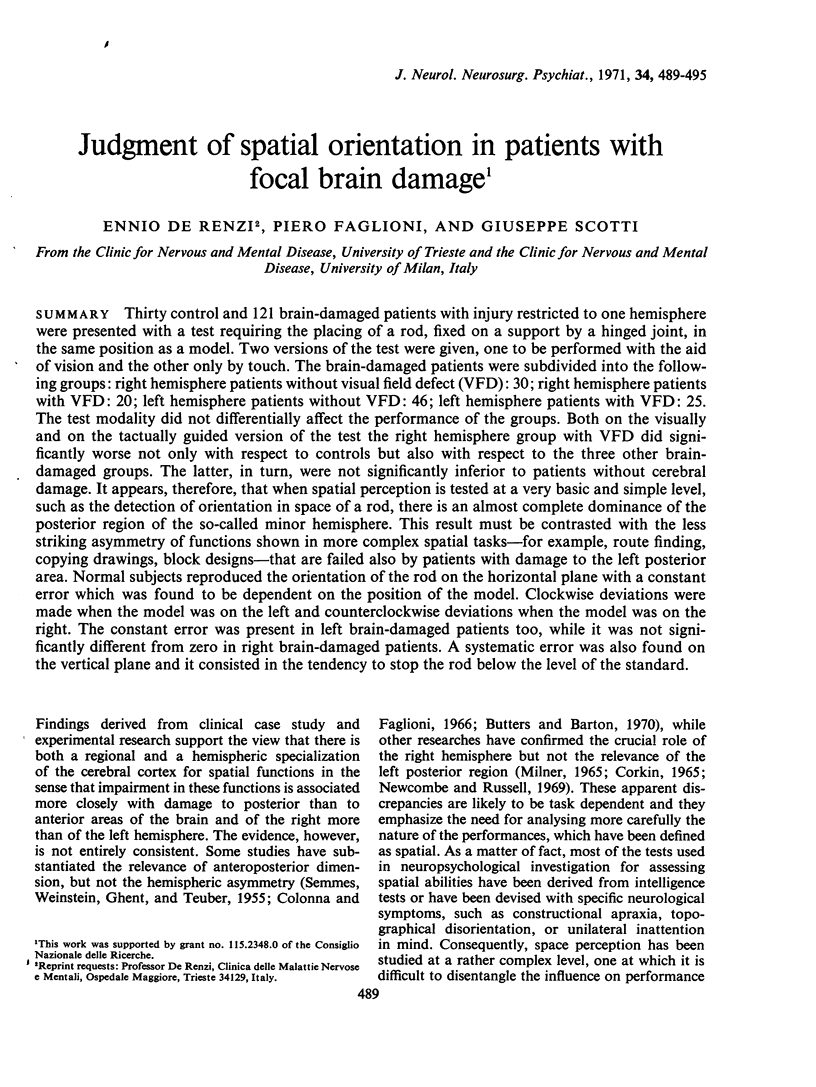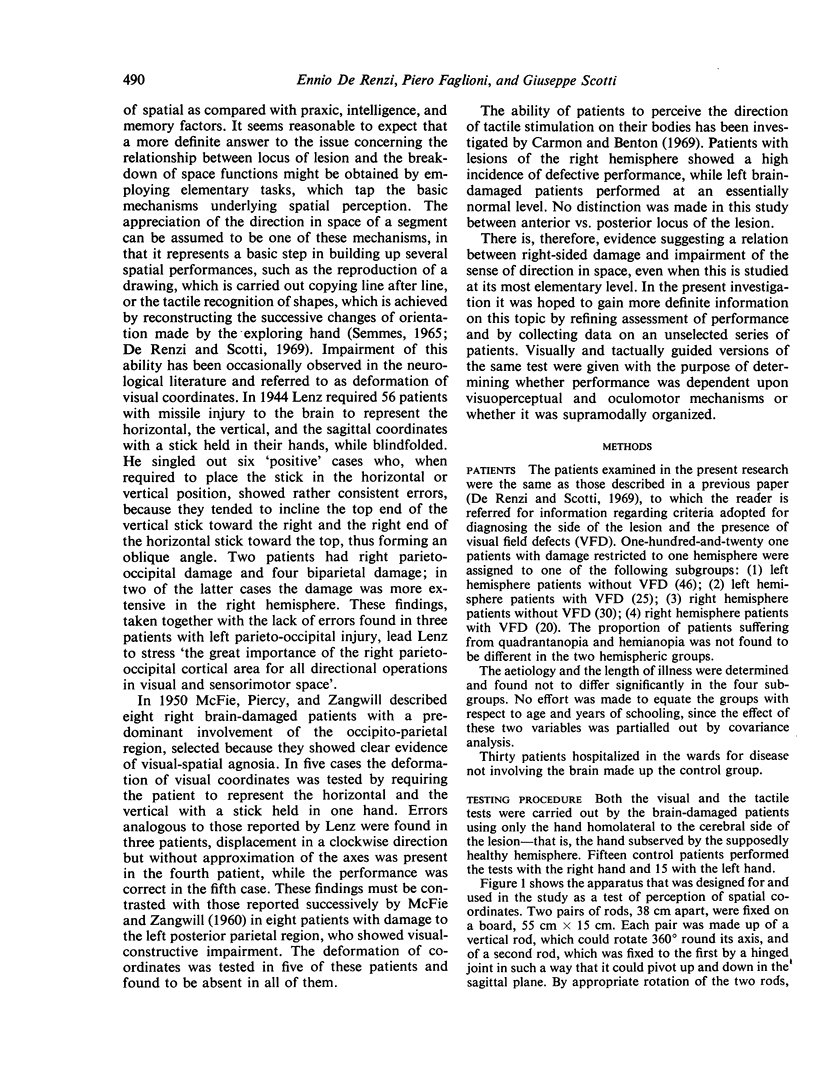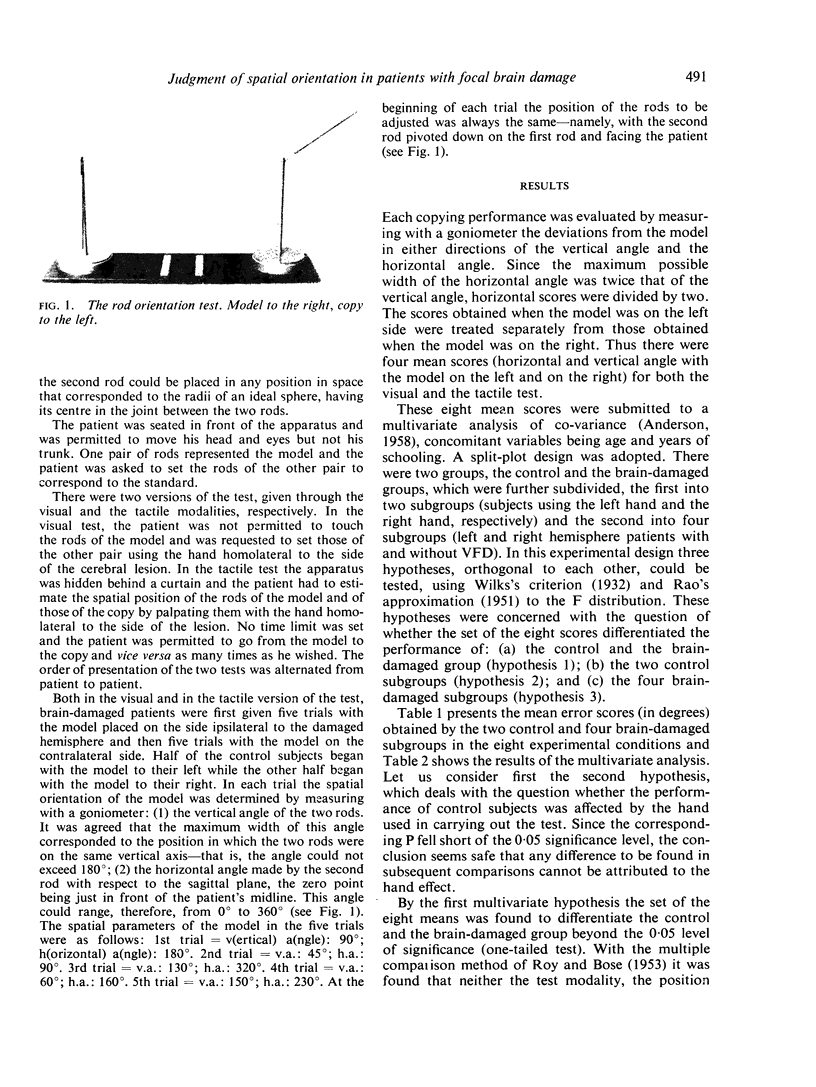Abstract
Thirty control and 121 brain-damaged patients with injury restricted to one hemisphere were presented with a test requiring the placing of a rod, fixed on a support by a hinged joint, in the same position as a model. Two versions of the test were given, one to be performed with the aid of vision and the other only by touch. The brain-damaged patients were subdivided into the following groups: right hemisphere patients without visual field defect (VFD): 30; right hemisphere patients with VFD: 20; left hemisphere patients without VFD: 46; left hemisphere patients with VFD: 25. The test modality did not differentially affect the performance of the groups. Both on the visually and on the tactually guided version of the test the right hemisphere group with VFD did significantly worse not only with respect to controls but also with respect to the three other braindamaged groups. The latter, in turn, were not significantly inferior to patients without cerebral damage. It appears, therefore, that when spatial perception is tested at a very basic and simple level, such as the detection of orientation in space of a rod, there is an almost complete dominance of the posterior region of the so-called minor hemisphere. This result must be contrasted with the less striking asymmetry of functions shown in more complex spatial tasks—for example, route finding, copying drawings, block designs—that are failed also by patients with damage to the left posterior area. Normal subjects reproduced the orientation of the rod on the horizontal plane with a constant error which was found to be dependent on the position of the model. Clockwise deviations were made when the model was on the left and counterclockwise deviations when the model was on the right. The constant error was present in left brain-damaged patients too, while it was not significantly different from zero in right brain-damaged patients. A systematic error was also found on the vertical plane and it consisted in the tendency to stop the rod below the level of the standard.
Full text
PDF






Images in this article
Selected References
These references are in PubMed. This may not be the complete list of references from this article.
- BENTON A. L., ELITHORN A., FOGEL M. L., KERR M. A PERCEPTUAL MAZE TEST SENSITIVE TO BRAIN DAMAGE. J Neurol Neurosurg Psychiatry. 1963 Dec;26:540–544. doi: 10.1136/jnnp.26.6.540. [DOI] [PMC free article] [PubMed] [Google Scholar]
- BIRCH H. G., BELMONT I., REILLY T., BELMONT L. Visual verticality in hemiplegia. Visual influences on perception. Arch Neurol. 1961 Oct;5:444–453. doi: 10.1001/archneur.1961.00450160094007. [DOI] [PubMed] [Google Scholar]
- Butters N., Barton M. Effect of parietal lobe damage on the performance of reversible operations in space. Neuropsychologia. 1970 Apr;8(2):205–214. doi: 10.1016/0028-3932(70)90008-4. [DOI] [PubMed] [Google Scholar]
- Carmon A., Benton A. L. Tactile perception of direction and number in patients with unilateral cerebral disease. Neurology. 1969 Jun;19(6):525–532. doi: 10.1212/wnl.19.6.525. [DOI] [PubMed] [Google Scholar]
- De Renzi E., Faglioni P., Scotti G. Hemispheric contribution to exploration of space through the visual and tactile modality. Cortex. 1970 Jun;6(2):191–203. doi: 10.1016/s0010-9452(70)80027-2. [DOI] [PubMed] [Google Scholar]
- De Renzi E., Scotti G. The influence of spatial disorders in impairing tactual discrimination of shapes. Cortex. 1969 Mar;5(1):53–62. doi: 10.1016/s0010-9452(69)80007-9. [DOI] [PubMed] [Google Scholar]
- ELITHORN A. A preliminary report on a perceptual maze test sensitive to brain damage. J Neurol Neurosurg Psychiatry. 1955 Nov;18(4):287–292. doi: 10.1136/jnnp.18.4.287. [DOI] [PMC free article] [PubMed] [Google Scholar]
- McFIE J., PIERCY M. F., ZANGWILL O. L. Visual-spatial agnosia associated with lesions of the right cerebral hemisphere. Brain. 1950 Jun;73(2):167–190. doi: 10.1093/brain/73.2.167. [DOI] [PubMed] [Google Scholar]
- SEMMES J., WEINSTEIN S., GHENT L., TEUBER H. L. CORRELATES OF IMPAIRED ORIENTATION IN PERSONAL AND EXTRAPERSONAL SPACE. Brain. 1963 Dec;86:747–772. doi: 10.1093/brain/86.4.747. [DOI] [PubMed] [Google Scholar]
- TEUBER H. L., LIEBERT R. S. Specific and general effects of brain injury in man; evidence of both from a single task. AMA Arch Neurol Psychiatry. 1958 Oct;80(4):403–407. doi: 10.1001/archneurpsyc.1958.02340100003001. [DOI] [PubMed] [Google Scholar]



